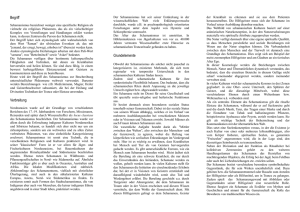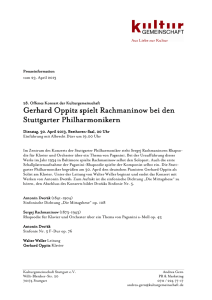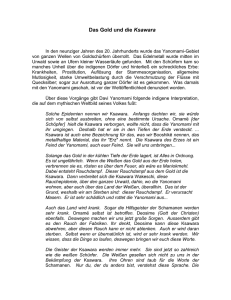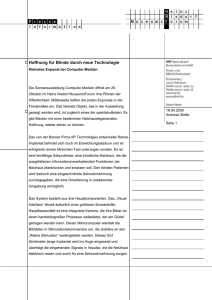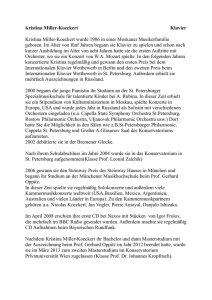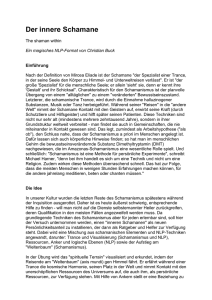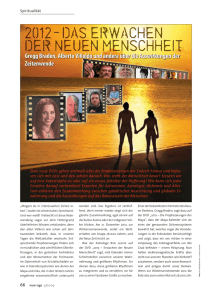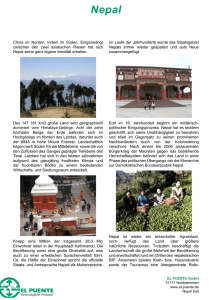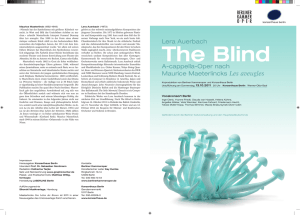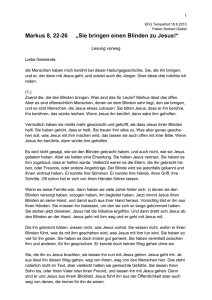Schamanen im Blinden Land
Werbung
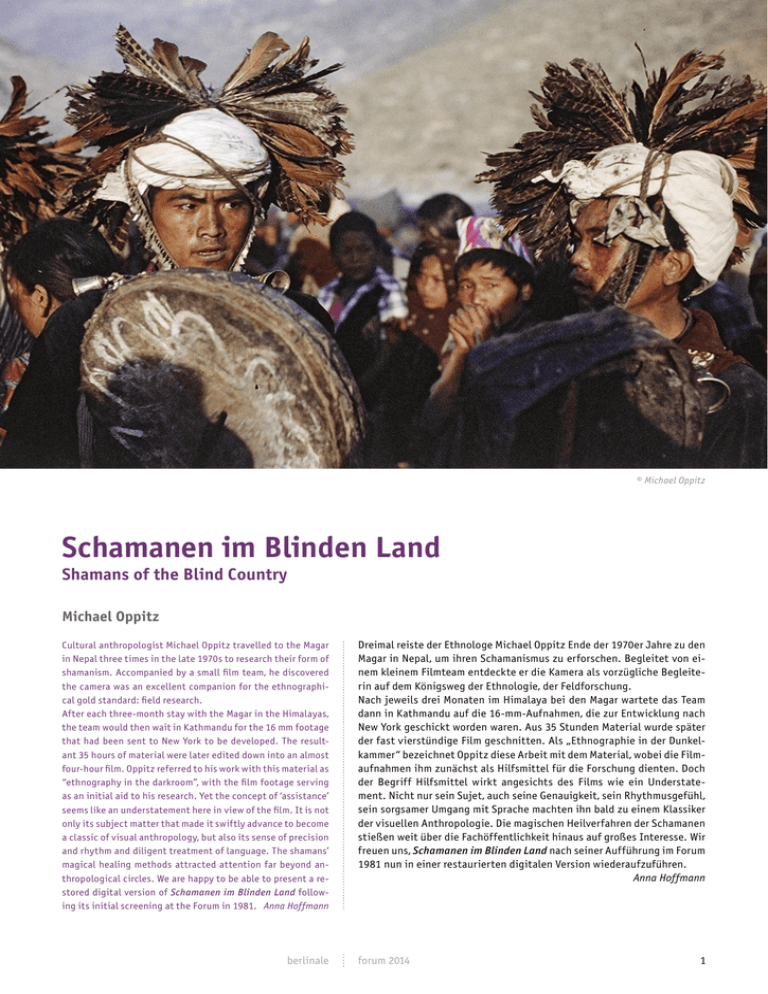
© Michael Oppitz Schamanen im Blinden Land Shamans of the Blind Country Michael Oppitz Cultural anthropologist Michael Oppitz travelled to the Magar in Nepal three times in the late 1970s to research their form of shamanism. Accompanied by a small film team, he discovered the camera was an excellent companion for the ethnographical gold standard: field research. After each three-month stay with the Magar in the Himalayas, the team would then wait in Kathmandu for the 16 mm footage that had been sent to New York to be developed. The resultant 35 hours of material were later edited down into an almost four-hour film. Oppitz referred to his work with this material as “ethnography in the darkroom”, with the film footage serving as an initial aid to his research. Yet the concept of ‘assistance’ seems like an understatement here in view of the film. It is not only its subject matter that made it swiftly advance to become a classic of visual anthropology, but also its sense of precision and rhythm and diligent treatment of language. The shamans’ magical healing methods attracted attention far beyond anthropological circles. We are happy to be able to present a restored digital version of Schamanen im Blinden Land following its initial screening at the Forum in 1981. Anna Hoffmann berlinale Dreimal reiste der Ethnologe Michael Oppitz Ende der 1970er Jahre zu den Magar in Nepal, um ihren Schamanismus zu erforschen. Begleitet von einem kleinem Filmteam entdeckte er die Kamera als vorzügliche Begleiterin auf dem Königsweg der Ethnologie, der Feldforschung. Nach jeweils drei Monaten im Himalaya bei den Magar wartete das Team dann in Kathmandu auf die 16-mm-Aufnahmen, die zur Entwicklung nach New York geschickt worden waren. Aus 35 Stunden Material wurde später der fast vierstündige Film geschnitten. Als „Ethnographie in der Dunkelkammer“ bezeichnet Oppitz diese Arbeit mit dem Material, wobei die Filmaufnahmen ihm zunächst als Hilfsmittel für die Forschung dienten. Doch der Begriff Hilfsmittel wirkt angesichts des Films wie ein Understatement. Nicht nur sein Sujet, auch seine Genauigkeit, sein Rhythmusgefühl, sein sorgsamer Umgang mit Sprache machten ihn bald zu einem Klassiker der visuellen Anthropologie. Die magischen Heilverfahren der Schamanen stießen weit über die Fachöffentlichkeit hinaus auf großes Interesse. Wir freuen uns, Schamanen im Blinden Land nach seiner Aufführung im Forum 1981 nun in einer restaurierten digitalen Version wiederaufzuführen. Anna Hoffmann forum 2014 1 The story of the film Die Geschichte dieses Films The completely restored and digitalised film will be shown in the framework of the Berlinale Forum 2014. Im Rahmen des Berlinale-Forums 2014 wird der vollständig restaurierte und digitalisierte Film gezeigt. Michael Oppitz shot Schamanen im Blinden Land on three expeditions between 1977 and 1979 under difficult physical conditions in a remote village in the Himalayas of West Nepal, near the Dhaulagiri massif; the film was completed in Cologne and New York in the autumn of 1980. The 223-minute film shot on 16mm colour negative had its world premiere on 15 October 1980 at the American Museum of Natural History in New York. Other premieres followed in February 1981 at the 11th International Forum of Young Film at the Berlin Film Festival, at Easter 1981 on Westdeutscher Fernsehen (with many later rebroadcasts) and in a harvested maize field of the Himalayan village Taka in the same year. The film enjoyed outstanding recognition around the world from then on and won first prize at the Festival dei Popoli in Florence (also in 1981). To this day it has enthusiastic adherents and has been studied and analysed at many institutes of visual anthropology and at art and film schools as a model of a powerfully individual and novel form of documentary film. It is considered a classic in its genre. A few years ago, the film’s negative material, which was stored in a film laboratory in New York, was lost en route to another lab and has never been found since. Only two of the colour copies made over the years are still in a halfway presentable state. Since specialists unanimously agree that the film is an irreplaceable document of an archaic way of life and religious practices – a local variant of shamanism that already vanished in northern Asia at the beginning of the twentieth century – it was imperative to rescue it for posterity by means of comprehensive restoration and digitalisation. UNESCO calls it a prime example of Intangible Cultural Heritage, a vital testimony of oral traditions, social and religious practices, indigenous knowledge and artful forms of dramatic performance. The film’s length – almost four hours – provides multifaceted glimpses into the mythical worldview of the shamans and a re-enactment of the epic everyday life of their local following. Michael Oppitz drehte Schamanen im Blinden Land auf drei Expeditionen zwischen 1977 und 1979 unter schwierigen physischen Bedingungen in einem abgelegenen Himalaya-Dorf West-Nepals in der Nähe des Dhaulagiri-Massivs; im Herbst 1980 wurde der Film in Köln und in New York fertiggestellt. Seine Weltpremiere erlebte der 223 Minuten lange (auf 16-mm Color-Negativ gedrehte) Film am 15. Oktober 1980 am American Museum of Natural History in New York. Es folgten weitere Premieren im Februar 1981 beim 11. Internationalen Forum des Jungen Films in Berlin, zu Ostern 1981 im Westdeutschen Fernsehen (mit etlichen späteren Wiederholungen) und auf einem abgeernteten Maisfeld des Himalaya-Dorfes Taka im gleichen Jahr. Fortan genoss der Film weltweit große Anerkennung und gewann beim Festival dei Popoli in Florenz (ebenfalls 1981) den ersten Preis. Bis heute hat er begeisterte Anhänger, und an vielen Instituten für Visuelle Anthropologie, Kunst- und Filmschulen steht er, als Modell für eine eigenwillige und neuartige Form des Dokumentarfilms, auf dem Lehrplan. Er gilt als ein Klassiker seines Genres. Vor einigen Jahren ging das Negativmaterial des Films, das in einem Kopierwerk in New York gelagert worden war, beim Transport in ein anderes Kopierwerk verloren und ist seither unauffindbar. Von den im Verlauf der Jahre gezogenen Farbkopien sind nachweislich nur noch zwei in einem halbwegs präsentablen Zustand erhalten. Da es sich bei dem Film, dem einhelligen Urteil von Fachleuten zufolge, um ein unwiederbringliches Dokument über eine archaische Lebensweise und Religionspraxis – über eine Lokalprägung des Schamanismus, der in Nordasien bereits zu Beginn des 20. Jahrhunderts ausgelöscht wurde – handelt, war es unumgänglich, ihn durch umfassende Restaurierung und Digitalisierung für die Nachwelt zu retten: als ein, wie die UNESCO es nennt, Musterbeispiel der Intangible Cultural Heritage, ein vitales Zeugnis mündlicher Überlieferungen, sozialer und religiöser Praktiken, indigenen Wissens und kunstvoller dramatischer Aufführungsformen. Die Länge des Films von nahezu vier Stunden ermöglicht vielseitige Einblicke in die mythische Weltsicht der Schamanen und den Nachvollzug des epischen Alltags ihrer lokalen Gefolgschaft. Die Gefahr der Auslöschung Facing extinction In this film I tried to bring three qualities into a form: the epic nature of shamanistic rituals; the mythical colouring of everyday life; and the transcendental aura of the actual landscape of a local society in the Himalayas. Not until the last third of the twentieth century did researchers get the chance to study shamanism with new eyes as a lived, current practice in the remote mountain regions of the Himalayas. I took this opportunity and, beginning in the mid-1970s, focussed on a local variant of the phenomenon: the healers of the northern Magar near the Dhaulagiri massif in northwestern Nepal. In the course of an 18-month field study and on three successive expeditions with a small camera team, I was able to document in word and image one of once-numerous local forms of shamanism. Schamanen im Blinden Land is the bestknown result of this research. (Quoting their myths, the Magar call their living space ‘blind country’, sarcastically regarding it as a place cursed with blindness.) berlinale In diesem Film habe ich versucht, drei Eigenschaften in eine Form zu bringen: die epische Natur der schamanischen Riten; die mythische Färbung des Alltagslebens; und die transzendentale Aura der realen Landschaft einer lokalen Gesellschaft des Himalaya. Erst im letzten Drittel des 20. Jahrhunderts entdeckten Forscher ihre Chance, den Schamanismus als eine gelebte Praxis der Gegenwart mit neuen Augen zu studieren: in den abgelegenen Bergregionen des Himalaya. Ich habe diese Gelegenheit wahrgenommen und mich ab Mitte der 1970er Jahre einer lokalen Prägung des Phänomens zugewendet: den Heilern der nördlichen Magar in der Nähe des Dhaulagiri-Massivs im nordwestlichen Nepal. Im Zuge einer Feldforschung von 18 Monaten und auf drei sukzessiven Expeditionen mit einem kleinen Kamerateam war es mir möglich, eine der ehemals zahlreichen örtlichen Ausprägungen des Schamanismus in Wort und Bild zu dokumentieren. Schamanen im Blinden Land ist das bekannteste Resultat dieser Forschungen. Der Film zeigt mit einer Länge von fast vier Stunden den Schamanismus der Magar in all seinen Facetten: als eine Tätigkeit örtlicher Glaubensheiler, die in einem langen Prozess der Initiation in ihre übernatürliche Berufung eingeführt werden. Dabei werden ohne theoretischen Ballast forum 2014 2 The film, almost four hours long, shows the shamanism of the Magar in all its facets as an activity of local faith healers who go through a long process of initiation into their supernatural calling. Without theoretical ballast, the film vividly shows many aspects of this religious practice from the perspective of the Magar themselves: How does one become a shaman? What tests must one undergo and what practices and knowledge must one learn to do so? What paraphernalia must be produced and employed? What worldview and what cosmological ideas guide the healer’s actions? What nocturnal rituals are performed to communicate with supernatural powers, and what myths, songs, and dances are performed in the ritual? How are the mythical stories of the ritual presentation integrated in the inhabitants’ lived present, and how are the shamans’ activities interwoven in the village’s daily life? How profane is the holy, how sacred the profane? Since its first screenings, the broad range of the film Schamanen im Blinden Land rapidly brought it recognition as the clearest and most complex document of shamanistic practice in a modern medium and as a pictorial testimony to a worldview that permeates all areas of life, but is in the process of vanishing. But shamanism is not the only thing whose existence is threatened all over the world (even in the remote Himalayas, it is vanishing with the spread of modern technologies, media, and ways of living); the document about it that is recognised as most important also faced extinction. The declared aim of this restoration is to avert this fate. Michael Oppitz Echo and effect Ever since its premiere, the film had extraordinary international success: at festivals in Europe, Asia and America; on tours; in commercial cinemas and on television; and at symposia and seminars at or outside of universities and colleges. In the field of visual anthropology, it prevailed and still holds its own as a model of a novel form of documentary film. Among artists with varied orientations, the film found powerful resonance – admiration, objection and inspiration. A few renowned names provide examples of their diversity: Joseph Beuys and Sigmar Polke in visual art (Beuys: ‘These shamans stole practically everything from me’); in music, John Cage, Pauline Oliveros and Dieter Schnebel; among performance artists and theoreticians, Richard Schechner and Joan Jonas; among writers, Bruce Chatwin and William S. Burroughs, who lent his voice as narrator to the English version of the film; and among experimental filmmakers, David Larcher, Harun Farocki and Jack Smith, as well as Robert Gardner in nonfiction film. The film is considered a classic document in ethnology, comparative religion and rituals studies; the general public sees it as testimony to archaic cultures that have no written languages. zahlreiche Aspekte dieser Religionspraxis aus der Perspektive der Magar selbst in anschaulichen Bildern vergegenwärtigt: Wie wird man Schamane? Welche Tests muss man durchlaufen, welche Praktiken und Kenntnisse dafür erwerben? Welche Paraphernalien sind herzustellen und zu verwenden? Welche Weltsicht, welche kosmologischen Vorstellungen leiten die Handlungen des Heilers? Welche nächtlichen Rituale werden zur Kommunikation mit übernatürlichen Kräften abgehalten, welche Mythen, Gesänge und Tänze kommen im Ritual zur Aufführung? Wie fügen sich die mythischen Geschichten des rituellen Vortrags in die gelebte Gegenwart der Bewohner, wie sind die Tätigkeiten der Schamanen in den Alltag des Dorfes verflochten? Wie profan ist das Heilige, wie sakral das Profane? In seiner Spannbreite ist der Film Schamanen im Blinden Land – als „blindes Land“ bezeichnen die Magar mit einem Zitat aus ihren Mythen ihren eigenen Lebensraum, den sie sarkastisch als einen mit Blindheit geschlagenen Ort betrachten – seit seinen ersten Ausstrahlungen sehr schnell zu dem anschaulichsten und komplexesten Dokument schamanischer Praxis in einem modernen Medium avanciert; als ein bildliches Zeugnis einer im Verschwinden begriffenen, alle Lebensbereiche durchdringenden religiösen Weltauffassung. Doch nicht nur der Schamanismus ist weltweit in seiner Existenz bedroht (selbst im abgelegenen Himalaya ist er durch Ausbreitung moderner Technologien, Medien und Lebensformen im Verschwinden begriffen); auch das anerkanntermaßen wichtigste Dokument über ihn stand vor seiner Auslöschung. Diesem Schicksal entgegenzuwirken, ist das erklärte Ziel dieser Restaurierung. Michael Oppitz Echo und Wirkung Dem Film war von seiner Premiere an ein außerordentlicher internationaler Erfolg beschieden: auf Festivals in Europa, Asien und Amerika, auf Tourneen, in kommerziellen Kinos und im Fernsehen, auf Symposien und in Seminaren innerhalb und außerhalb von Universitäten und Hochschulen. In der Visuellen Anthropologie konnte er sich als Modell für eine neuartige Form des Dokumentarfilms durchsetzen und bis heute behaupten. Unter Künstlern unterschiedlicher Orientierungen löste der Film starke Resonanz aus – Bewunderung, Widerspruch, Inspiration. Als Beispiele für die Vielfalt seien nur einige bekannte Namen genannt: Joseph Beuys und Sigmar Polke in der bildenden Kunst (Beuys: „Diese Schamanen haben praktisch alles bei mir geklaut“); in der Musik John Cage, Pauline Oliveros, Dieter Schnebel; unter Performance-Künstlern und -Theoretikern Richard Schechner und Joan Jonas; unter Schriftstellern Bruce Chatwin und William S. Burroughs, der in der englischen Fassung des Films dem Erzählerpart seine Stimme gab; und unter den experimentellen Filmemachern David Larcher, Harun Farocki und Jack Smith, sowie – für den nicht-fiktionalen Film – Robert Gardner. In der Ethnologie, in der Vergleichenden Religionswissenschaft und in der Ritualforschung gilt der Film als klassisches Dokument; und beim allgemeinen Publikum als Zeugnis archaischer Kulturen ohne Schrift. Weitere Informationen zu dem Film Further information berlinale forum 2014 3 Michael Oppitz was born in 1942 in the Krkonoše Mountains of Silesia, Poland. He studied anthropology, sociology and Sinology at Berkeley, Bonn and Cologne, and earned his PhD in 1974 with a dissertation on the history of structural anthropology. Along with guest professorships in England, France and the United States, he was a professor of anthropology at Zurich University and the director of the university’s Ethnographic Museum from 1991 until his retirement in 2008. Starting in the 1960s, he carried out extensive fieldwork in the Himalayas with the Sherpa (1965) and the Magar (1977–1984), in Yunnan Province with the Naxi (1995–1996), and in Sichuan Province with the Qiang (2000–2001). He is the author of numerous publications on anthropological and ethnographic subjects and has made several short films. Michael Oppitz wurde 1942 auf der Schneekoppe im Riesengebirge geboren. Er studierte Ethnologie, Soziologie und Sinologie in Berkeley, Bonn und Köln und promovierte 1974 mit einer Arbeit zur Geschichte der strukturalen Anthropologie. Neben Gastprofessuren in England, Frankreich und den USA war er von 1991 bis zu seiner Emeritierung 2008 Professor für Ethnologie an der Universität Zürich und Direktor des dortigen Ethno­ graphischen Museums. Seit den 1960er Jahren hat er intensive Feld­­forschungsreisen unternommen: ins Himalaya zu den Sherpa (1965) und den Magar (1977–1984), zu den Naxi in Yunnan (1995–1996) und den Qiang in Sichuan (2000–2001). Er hat zu anthropologischen und ethnologischen Themen publiziert und mehrere Kurzfilme gedreht. Films 1978: Pilger an der Quelle des Padmasambhava (20 min.). 1980: Schamanen im Blinden Land / Shamans of the Clind Country (223 min., Forum 1981). 2011: Mit Trommel und Heli zum Jenseitspass (13 min.). 2012: Rituelle Reise in die Unterwelt (12 min.). 2013: Zu den Wassern des Vergessens (14 min.). Filme 1978: Pilger an der Quelle des Padmasambhava (20 Min.). 1980: Schamanen im Blinden Land (223 Min., Forum 1981). 2011: Mit Trommel und Heli zum Jenseitspass (13 Min.). 2012: Rituelle Reise in die Unterwelt (12 Min.). 2013: Zu den Wassern des Vergessens (14 Min.). Country: Nepal, Germany, USA 1980. Production company: Neo­ Film GmbH, Berlin (Germany); Nachtaktivfilm, Berlin (Germany). Director: Michael Oppitz. Screenwriter: Michael Oppitz. Director of photography: Jörg Jeshel, Rudi Palla. Sound: Barbara Becker. Editor: Hella Vietzke. Producer: Wieland SchulzKeil (NeoFilm GmbH). Restoration: Brigitte Kramer, Jörg Jeshel (Nachtaktivfilm). Land: Nepal, Deutschland, USA 1980. Produktion: NeoFilm GmbH, Berlin (Deutschland); Nachtaktivfilm, Berlin (Deutschland). Regie: Michael Oppitz. Buch: Michael Oppitz. Kamera: Jörg Jeshel, Rudi Palla. Ton: Barbara Becker. Schnitt: Hella Vietzke. Produzent: Wieland Schulz-Keil (NeoFilm GmbH). Restaurierung: Brigitte Kramer, Jörg Jeshel (Nachtaktivfilm). Format: DCP, Farbe. Länge: 223 Min. Sprache: Kham, Englisch. Uraufführung: 15. Oktober 1980, New York City (USA). Format: DCP, colour. Running time: 223 min. Language: Kham, English. World premiere: 15 October 1980, New York City (USA). berlinale forum 2014 4
